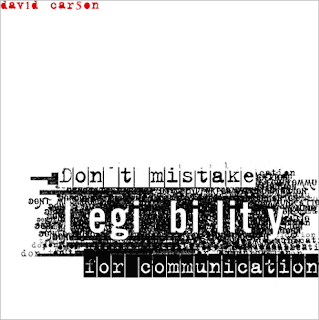Inspiration? It is elusive at times, abundant at others, always a state of mind. What inspires me? Graphic artists that changed the world, altered the look of design, spoke out for social change, inspired so many: William Morris, Jules Cheret, A.M. Cassandre, Josef Müller-Brockman, Saul Bass, Milton Glaser, Tibor Kalman, David Carson, April Grieman, and so many more. These were some of the innovators, pioneers of their times - went beyond the norm, embraced new technology, and created a new style of design – changed the world. Inspiration? Yes. For me, the ability of these artists to change society through their work is an inspiration, of course. Who wouldn’t admire the people who impacted our world for the better especially since graphic design is so prevalent in our lives? This is the big picture – big inspiration – big change. But for me, right now, the simple is inspiring - text perfectly placed on a page; a well-balanced composition; beautiful color combinations; simple, geometric imagery or photography; and reflection of the mood of the piece. Works of art done by some of the very designers that created the big picture? Yes. My inspiration…
The idea of a simple, well-balanced, layout without excessive ornamentation was promoted by the Swiss-style designers, late-modernists, and is still carried out by contemporary designers today.
The 1975 poster by Josef Müller-Brockman entitled “akari” is an advertisement for an exhibition in Germany for a Japanese light company (Akari). This is simplicity at its finest, the beautiful circle of light and its reflection, the four-column grid layout of the text which includes the simple title (all lower case, Helvetica), and the simple black background.
The work of late-modernist and contemporary designer Saul Bass for the film Spartacus (1960) is also a simple composition that motivates me to create. The geometric text; the artfully-drawn, abstract image; the simple & powerful color-scheme; and the white-space make this poster an amazing visual representation of the movie and man portrayed.
Work of contemporary designer Woody Pirtle is a great inspiration to me. I like that he uses simplicity to advocate for social change. In 2002, he was commissioned to design a series of posters for Amnesty International to represent “The Universal Declarations of Human Rights.” This particular poster is a plea for “Freedom from Discrimination.” Again, the simplicity of the design is appealing to me. The concept is amazing - using crayons to represent the races of humanity then removing the color and washing them with flat color to represent equality. Very strong imagery and symbolism. The minimal text block in varying weights of Helvetica, the vertical title, and Article 02 add to the powerful nature of the piece.
Why is it important to me to be able to convey key messages in a simple, well-constructed design? The old saying “A picture is worth a thousand words” has been thrown on its head in this digital world. Just go to any website, we are bombarded with imagery, advertising, flashing reminders that we need to refinance, lose belly fat, find cheaper long distance. The messages are confounded, lost in a vibrating blur. Just driving down the highway, billboards speed by and offer us solutions to our needs – drink Jack Daniels and feel good, shop at Macy’s and you’ll look like this gorgeous model, get your McLatte at McDonalds TURN HERE! Too much, too fast. But when I see a simple, well-composed, poignant design, the message strikes me with such clarity. In this world, where people are overloaded with information, we don’t spend enough time looking at one thing – in fact, we spend a lot of time ignoring the abundance of information presented by our surroundings. The ability to convey the message with clarity, beauty, and straightforwardness is even more important in this time of information overload.
What will I do next? I hope to learn through taking more graphic design classes and observing the world around me. I am sure that my tastes will change over time. Just taking my first graphic design class has changed my view on design, art, history, and how entwined they are. How history changed design and how design changed history. I will take classes, make observations, read, study, and learn with an open mind. Will my inspiration change? Probably. Will I appreciate new design styles? With anticipation. Will I still value text perfectly placed on a page; a well-balanced composition; beautiful color combinations; simple, geometric imagery or photography while reflecting the mood? Absolutely.
“Art washes from the soul the dust of everyday life.” -- Picasso











